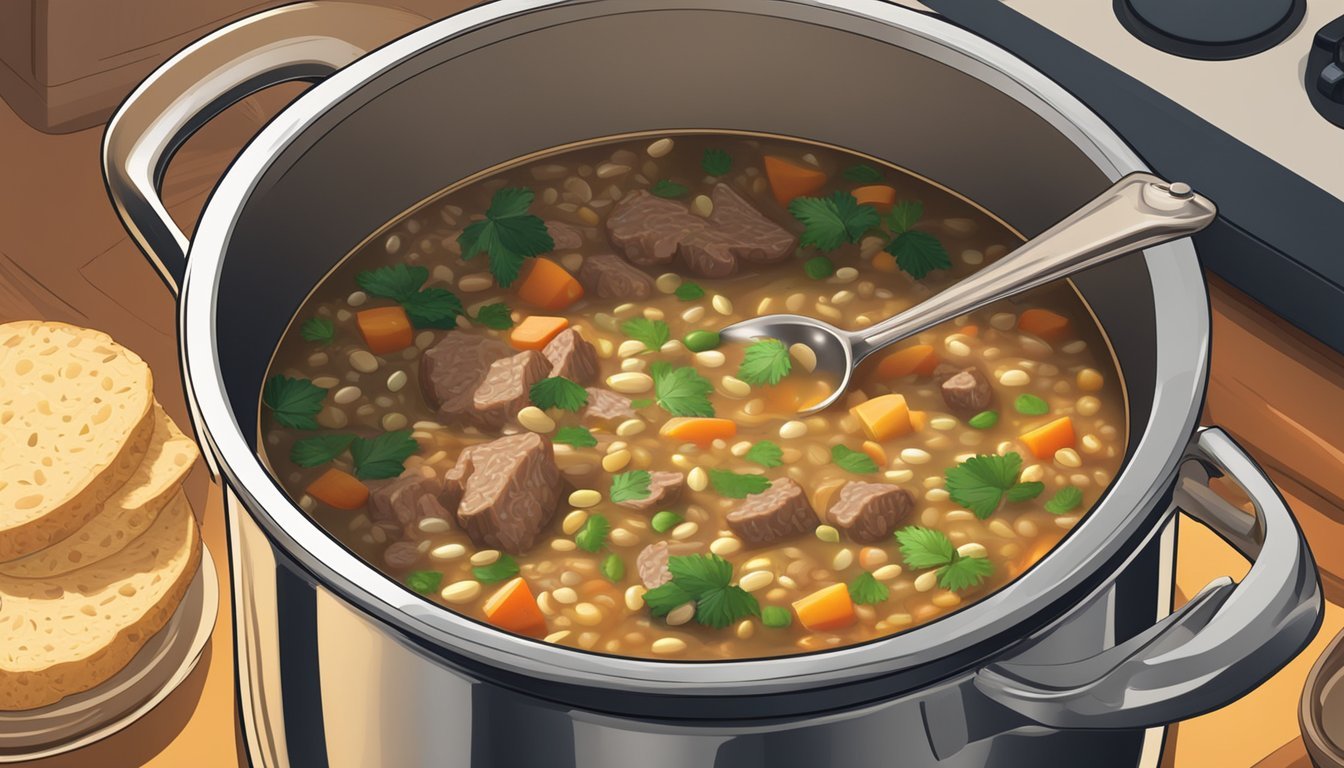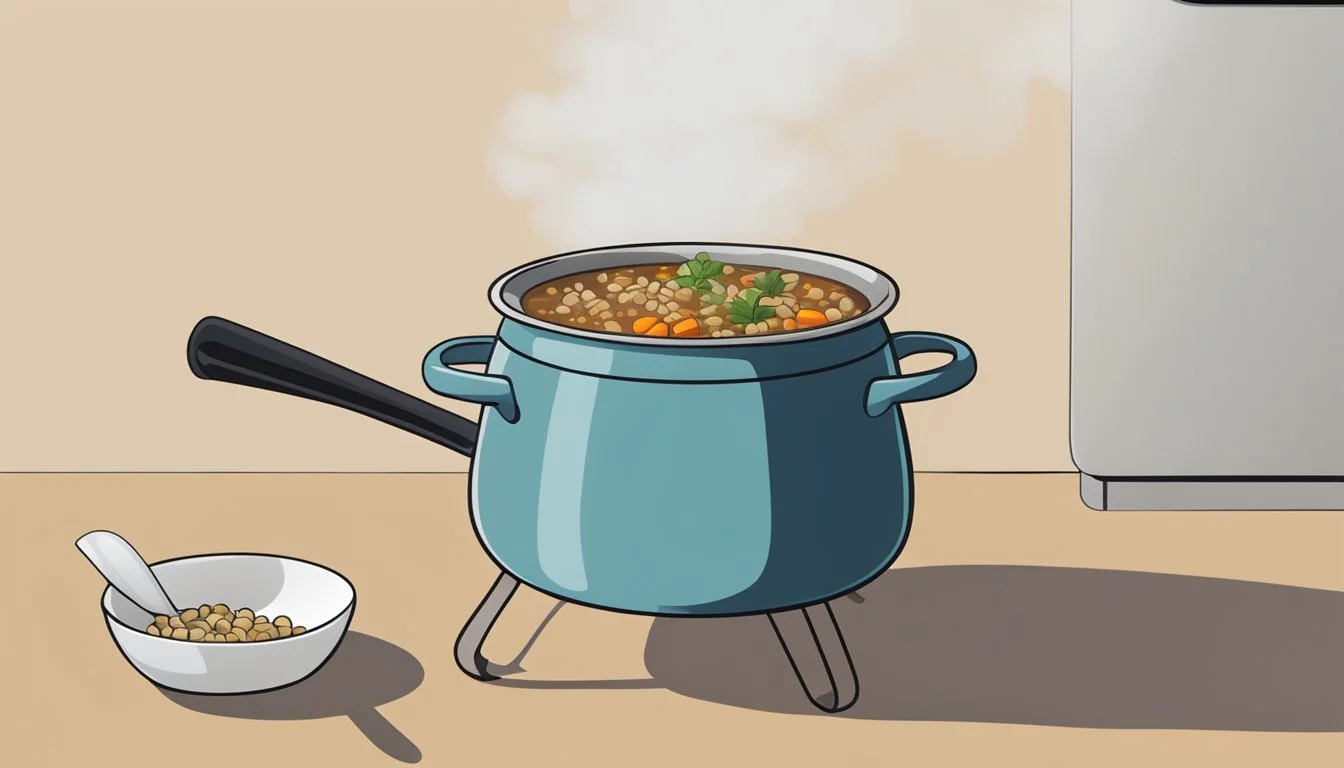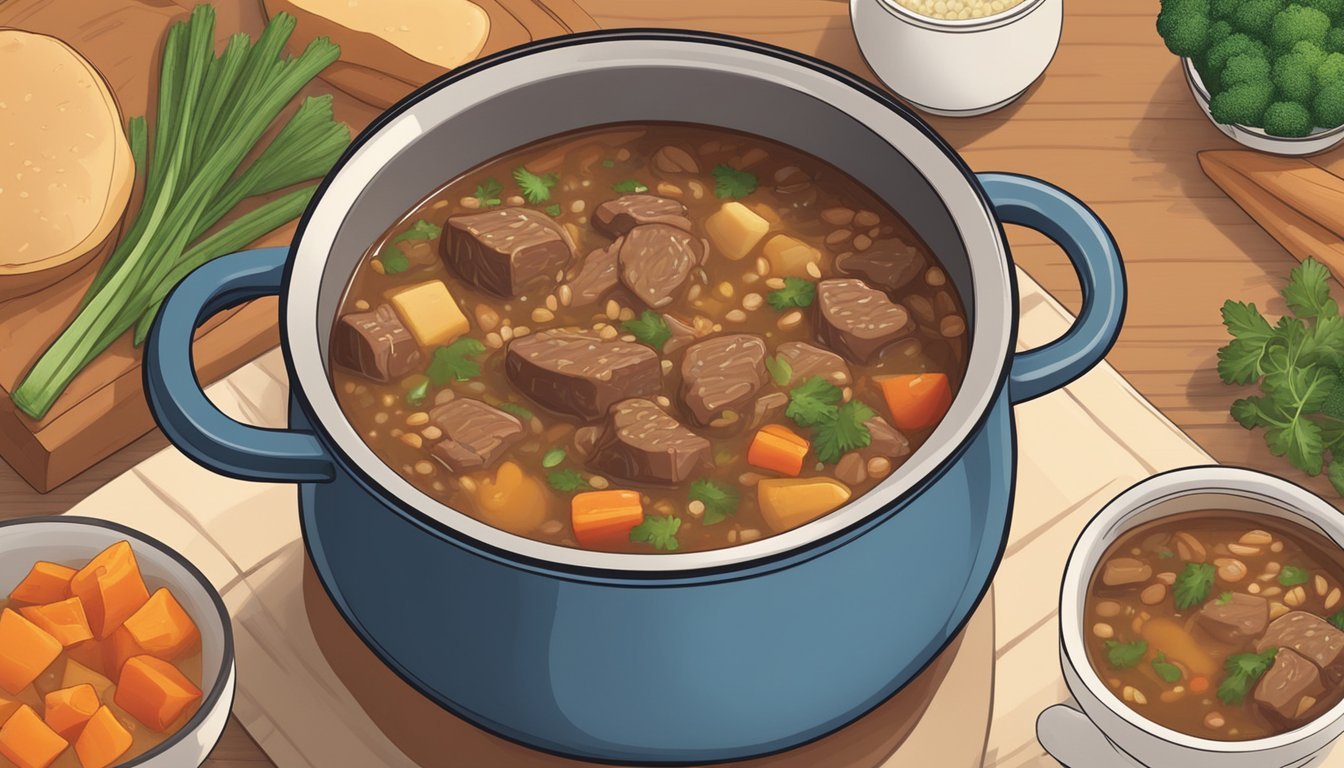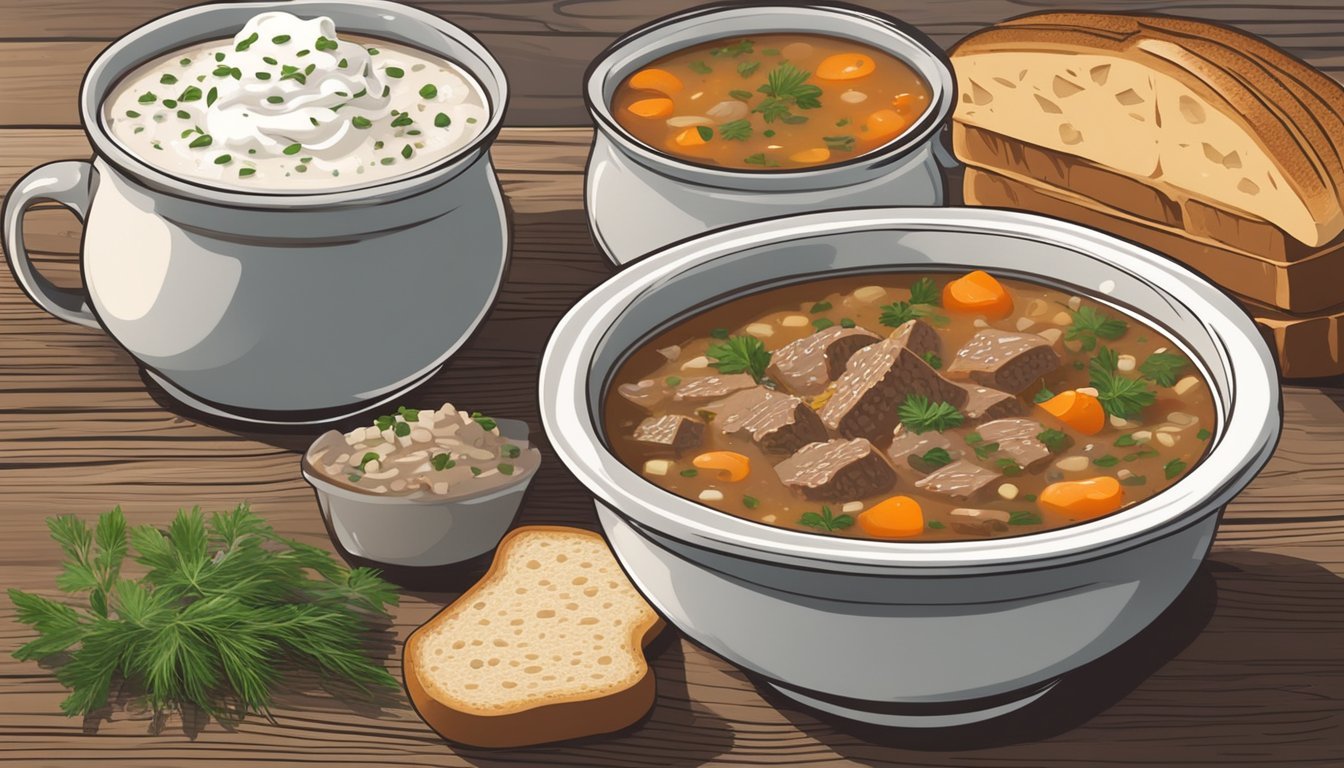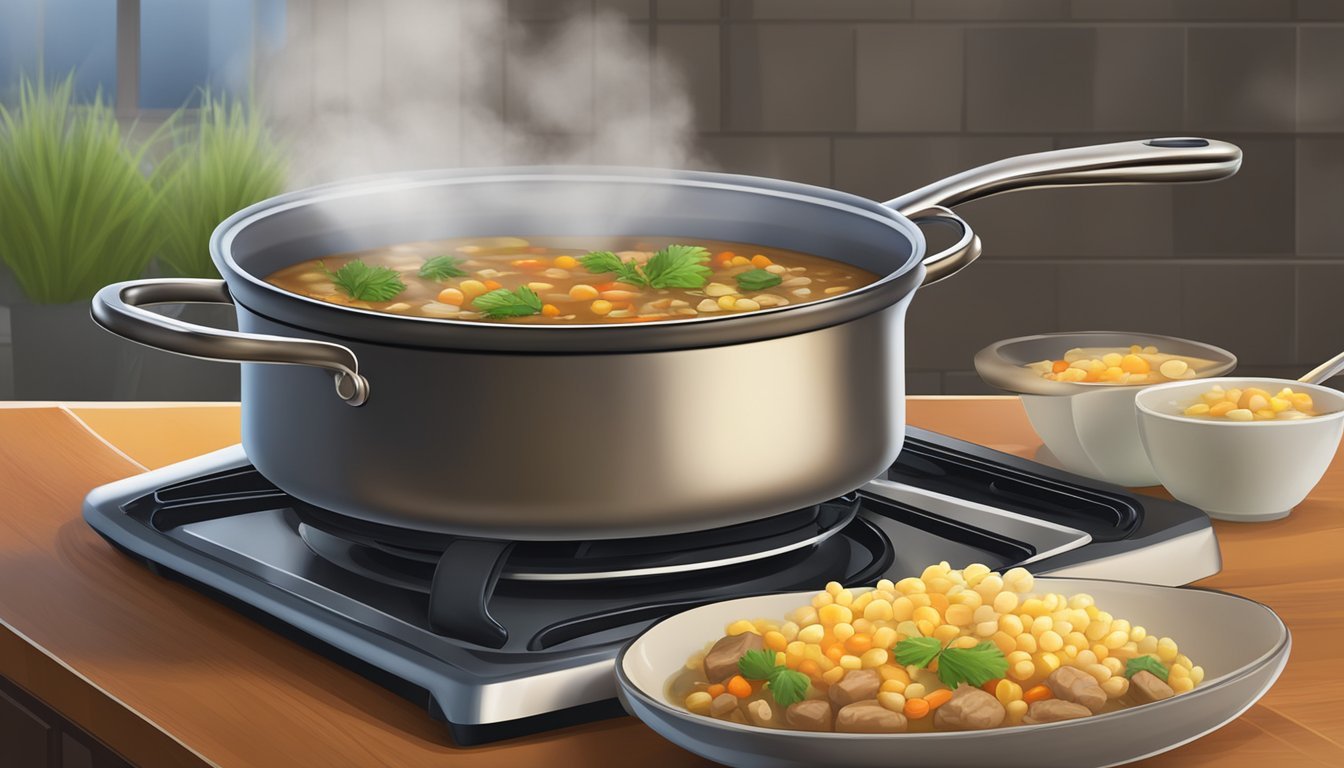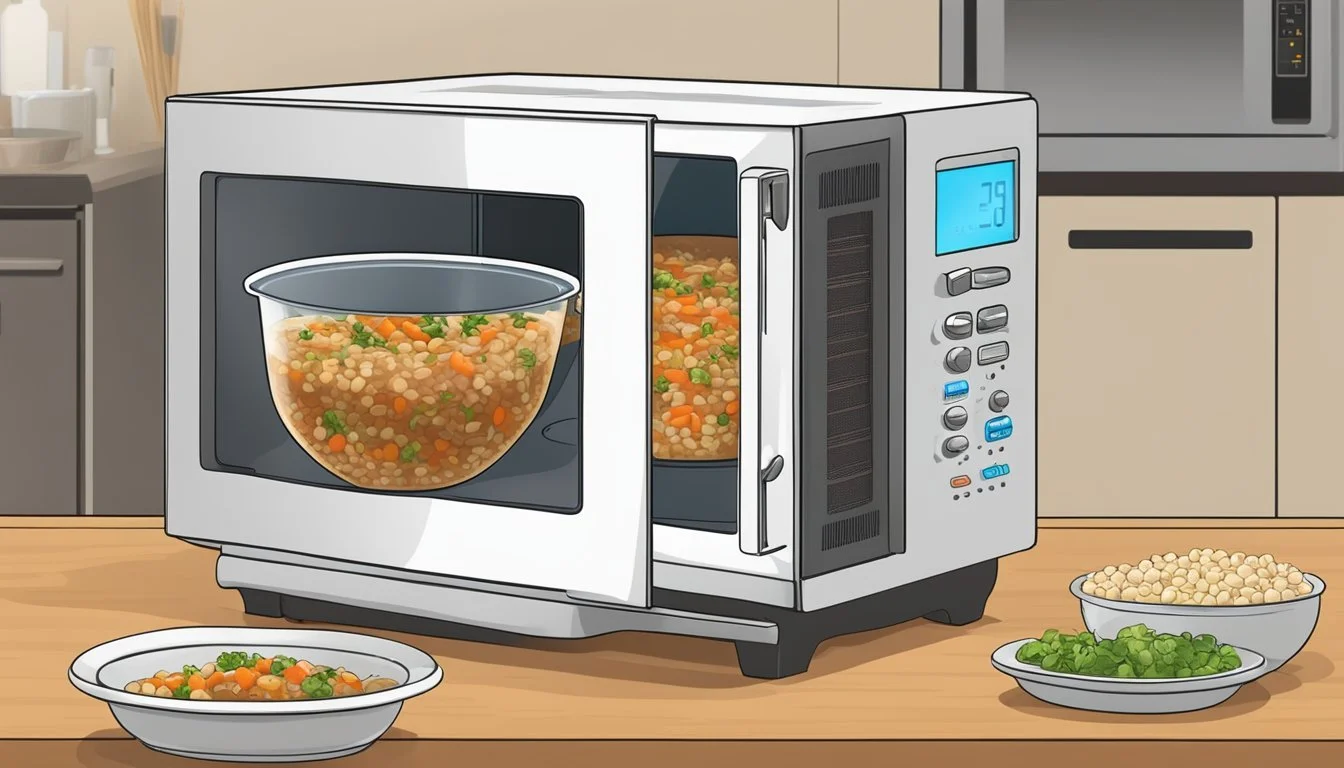Best Way to Reheat Beef Barley Soup
Ensuring a Hearty Texture Every Time
Beef (What wine goes well with beef?) barley soup is a classic comfort dish, treasured for its robust flavor and satisfying blend of tender beef, vegetables, and chewy barley grains. When it comes to reheating this hearty soup, the key is to preserve its rich texture and prevent the ingredients from becoming overcooked. The process must ensure that the beef stays succulent, the vegetables retain their bite, and the barley remains intact, contributing to the overall mouthfeel and taste that make this soup a favorite.
Reheating methods vary, but some are more effective than others for this type of dish. The goal is to achieve an even distribution of heat without allowing the soup to reach a boil, which can toughen the beef and make the barley mushy. They should consider the components of the soup and their individual reheating needs—beef may require a gentler heat to avoid drying out, while the barley might need a bit more time to warm through without losing its texture.
Temperature control is essential for the soup's integrity. Whether they're using a stovetop, microwave, or oven, careful attention to temperature will result in a reheated soup that is as satisfying as when it was first prepared. Monitoring the heat and stirring periodically can make a significant difference, ensuring that each spoonful retains the comfort and homeliness that beef barley soup is known for.
Understanding Beef Barley Soup
Beef barley soup is a classic dish known for its robust flavors and nutritional value. Its combination of tender beef, fiber-rich barley, and a variety of vegetables make it a hearty option for any meal.
Components of Beef Barley Soup
Beef: Typically, the soup includes cubed beef, seared to perfection, providing a savory base that contributes both flavor and protein.
Barley: Pearl barley is most commonly used, adding a chewy texture and an excellent source of fiber.
Vegetables: A traditional mirepoix of onions, carrots, and celery, along with any other desired vegetables, enhances the soup's nutritional profile and taste.
Broth: A rich beef or vegetable broth ties all the ingredients together, infusing the soup with moisture and depth of flavor.
Benefits of Hearty Beef Barley Soup
Beef barley soup offers several benefits:
Nutritional Value: It's a well-rounded meal that's packed with essential nutrients, protein, and fiber.
Satiety: The combination of ingredients provides a feeling of fullness, making it ideal for those seeking a satisfying meal.
Versatility: One can easily customize the soup with various vegetables and seasonings to cater to personal preferences.
Preparation Tips Before Reheating
Proper reheating of beef barley soup begins with correct storage and preparation before it even hits the stove again. These steps ensure that the soup maintains its hearty texture and flavors.
Proper Storage Techniques
In the Freezer:
For long-term storage, one should freeze the beef barley soup.
It is crucial to cool the soup completely before transferring it to an airtight container or heavy-duty freezer bags.
Soup can be kept frozen for up to 3 months; label it with the date to keep track of freshness.
In the Fridge:
When refrigerating, use shallow, airtight containers to cool the soup quickly and prevent bacterial growth.
The soup should be consumed within three to five days for optimal quality.
Pre-Reheat Preparation
Thaw the soup overnight in the fridge if it was stored in the freezer.
Before reheating, remove the soup from the fridge and let it sit at room temperature for about 20 minutes; this will reduce the temperature gap, allowing for more even reheating.
Separate any solid ingredients like the beef and pearl barley if they are sticking together, ensuring a consistent texture upon reheating.
If the soup appears thick, mix in a small amount of beef broth or water to adjust consistency.
Fresh parsley should be reserved and added after reheating to preserve its vibrant color and flavor.
Olive oil, if used in the original preparation, may solidify in the fridge; it will liquefy again when heated, so stirring occasionally during the reheating process can help reincorporate the oil for a well-emulsified texture.
Reheating Methods for Best Results
To ensure beef barley soup retains its hearty texture and rich flavor when reheating, selecting the right method is critical. Whether using the stovetop, microwave, or oven, gentle reheating is key to preventing overcooking of the barley and beef.
Stovetop Reheating Method
Heating beef barley soup on the stovetop allows for even heat distribution and better control over the temperature. One should use a heavy-bottomed pot or Dutch oven to avoid scorching. The soup should be reheated over medium-low heat, stirring occasionally to maintain a uniform temperature and integrate flavors, like Worcestershire sauce, evenly. It's important to bring the soup just to a simmer, not a boil, to maintain the integrity of the ingredients.
Microwave Reheating Method
For a quicker option, the microwave can be used for reheating beef barley soup. The soup must be placed in a microwave-safe bowl, and it's advisable to cover it with a microwave-safe lid or wrap it with a microwave-safe plastic wrap to retain moisture. To avoid cold spots, stir the soup every minute. Typically, heating on medium power in two-minute intervals until the desired temperature is reached ensures even warming.
Oven Reheating Technique
Using the oven to reheat beef barley soup is an excellent technique for bringing larger quantities back to temperature. Preheat the oven to 350°F. The soup should be transferred to an oven-safe dish, covered with aluminum foil to prevent moisture loss and keep the heat inside. Heat the soup in the oven for about 10 to 15 minutes or until it's thoroughly heated through. Care should be taken to not leave it in the oven too long, as prolonged heating can dry out the soup and overcook the ingredients.
Maintaining Texture and Flavor
When reheating beef barley soup, a focus on the right temperatures and freshness additions is crucial to preserve its hearty texture and rich flavors.
Optimal Heating Temperatures
One should heat beef barley soup slowly and steadily to avoid overcooking the tender beef and vegetables. A moderate temperature range of 165°F to 185°F is ideal. This ensures the soup recipe heats through while retaining a thick consistency. Microwaving can be done in increments, stirring occasionally to distribute heat evenly. On the stove, a gentle simmer on low-to-medium heat is best, occasionally stirring to maintain uniformity and prevent the bottom from scorching.
Adding Freshness After Reheating
After the soup has been reheated to the desired temperature, infusing it with a touch of freshness can elevate the taste and texture significantly:
Fresh Herbs: Add a sprinkle of fresh herbs, like parsley or thyme, to reintroduce a vibrant note to the dish.
Seasoning Adjustment: Often, flavors mellow after storage. A pinch of salt or pepper can reinvigorate the soup’s seasoning profile.
Worcestershire or Tomato: A dash of Worcestershire sauce or a spoonful of tomato paste can reintroduce the rich umami tones that may have diminished.
Maintaining the tenderness of the beef and the robust quality of the vegetables while reinforcing the rich, flavorful nature of the soup ensures an enjoyable reheated beef barley soup experience.
Accompaniments and Serving Suggestions
When presenting beef barley soup, one must consider the side dishes and garnishes that complement its hearty characteristics. The right selection elevates the dish from a simple meal to a comforting dining experience.
Choosing the Right Side Dishes
Crusty bread is almost non-negotiable when serving beef barley soup. Its crunchy texture perfectly complements the soup's richness, making it ideal for sopping up every satisfying spoonful. Here's a brief list of side dishes that pair well with beef barley soup:
Dinner Rolls: Soft, light, and slightly sweet; they absorb the soup's flavors brilliantly.
Garlic Bread: For a fragrant and savory touch, garlic bread adds depth to the meal.
Green Salad: A simple green salad with a vinaigrette dressing offsets the soup's richness.
To maintain the soup's integrity, one should serve it hot with sides that will not overpower its robust flavor profile.
Presentation and Garnishing
Beyond taste, presentation plays a key role in the enjoyment of beef barley soup. A ladle should be used to serve the soup carefully to maintain its hearty texture. A proper garnish like a sprinkle of fresh parsley can add a touch of color and a mild, herby freshness. For an aromatic kick, a drizzle of olive oil just before serving adds a hint of fruitiness to the dish.
One must remember that a well-thought-out presentation not only makes the soup more inviting but also enhances the overall sensory experience of comfort food.
Advanced Techniques and Variations
This section explores the nuances of both reheating frozen beef barley soup to retain its heartiness and creating delicious variations using the basic recipe.
Reheating Frozen Beef Barley Soup
When dealing with frozen beef barley soup, it's essential to thaw it properly before reheating. The best way to do this is to transfer the frozen soup to the refrigerator and allow it to thaw overnight. Once thawed, the soup can be reheated over a low to medium flame on the stove. This method preserves the soup's texture and flavor, ensuring that the beef, such as chuck roast or stew meat, does not become tough, and vegetables like carrots and celery maintain their structure.
Stovetop Method:
Step 1: Place thawed soup in a pot.
Step 2: Reheat gently on a low to medium flame.
Step 3: Stir occasionally to distribute heat.
Creating Variations of the Basic Recipe
To tweak the standard beef barley soup, chefs recommend incorporating alternative ingredients to add depth or a unique twist. For instance, the addition of red wine can lend a robust flavor that complements the savoriness of the beef chuck roast. Alternatively, mushrooms can be sautéed with the onions to introduce an earthy note. Kale, a hearty green, can be added in the last few minutes of cooking for a nutrient-rich enhancement, and it retains its texture and color well.
Ingredient Variations:
Red Wine: Adds depth to the broth.
Mushrooms: Provides an earthy flavor.
Kale: Offers nutrients and texture.
Beef Varieties: Chuck roast or stew meat for tenderness.
Troubleshooting Common Reheating Issues
When reheating beef barley soup, it's crucial to maintain the soup's hearty texture and avoid common pitfalls such as sogginess in the barley and a loss of beef's tenderness.
Avoiding Sogginess in Barley
To prevent pearled barley from becoming overly soggy, one should reheat the soup gradually at a moderate temperature. If the soup is reheated in the oven, a temperature of 350°F (175°C) is generally optimal. Consider these steps:
Preheat the oven to 350°F (175°C).
Transfer the soup to an oven-safe dish and cover with a lid or foil to retain moisture.
Heat the soup for 25-30 minutes, checking periodically to ensure the barley retains its shape and texture.
When reheating on the stove:
Warm the soup over low to medium heat.
Stir occasionally to distribute heat evenly and monitor the consistency of the barley.
Retaining Beef Texture
The texture of the beef stew meat in the soup is preserved best by gentle reheating. For this purpose:
Reheat slowly in a saucepan over low to medium heat, allowing the beef's fibers to warm without tightening and toughening.
If using a microwave, reduce the power setting to prevent the beef from overcooking.
When seasoning, be mindful of the salt content, as the flavors may concentrate when the soup is cooled. It may be necessary to adjust the levels of salt and pepper after reheating. Always taste the soup before serving, and season with black pepper or salt as needed.
By adhering to these strategies, the quality of the beef broth is maintained, ensuring a flavorful and desirable texture throughout the reheating process.
Safety Considerations and Best Practices
When reheating beef barley soup, it's imperative to maintain the integrity of the protein and robust flavors such as thyme and bay leaves while also ensuring that food safety guidelines are adhered to. The following will outline the necessary steps for reheating this hearty soup without compromising on safety and quality.
Food Safety During Reheating
The temperature: Soup leftovers should be reheated to an internal temperature of 165°F to ensure that any potential bacteria have been eliminated. This is crucial when dealing with protein-rich foods like the beef in beef barley soup.
The method: To avoid uneven heating, stirring the soup occasionally while reheating can help maintain an even temperature throughout. Whether one is using a stovetop or an oven, one must ensure that the entire dish reaches the appropriate temperature.
Storage: Before reheating, the soup should have been stored properly. Food should cool to room temperature before being divided into smaller portions and refrigerated or frozen. This accelerates cooling and limits bacterial growth.
Best Practices for Repeated Reheating
Limit frequency: Each time a dish is reheated, its quality can diminish. Therefore, it’s recommended to only reheat the quantity of beef barley soup that one intends to consume at that time.
Maintain moisture: During reheating, broth can evaporate, leaving the soup less silky and the beef tough. Adding water or broth when reheating can help preserve the soup's moisture.
Stovetop: Simmer the soup on low heat, occasionally stirring, to keep the beef tender.
Oven: Reheat in an oven-safe dish at a low temperature, covered, to retain moisture without drying out the ingredients.
Herbs: To refresh the flavors of herbs such as thyme and bay leaves, they may be added during the latter part of reheating, as prolonged exposure to heat can cause their flavors to dissipate.
By adhering to these safety considerations and best practices, one can enjoy their hearty beef barley soup with its texture and flavor intact.
Conclusion
When reheating beef barley soup, a gentle approach maintains its heartiness. Microwave reheating should include stirring at intervals to ensure even heat distribution, while stovetop reheating benefits from a low and slow simmer.
Key points to remember for optimal results:
Microwave: Use a microwave-safe container, cover loosely, and heat in increments, stirring frequently.
Stovetop: A heavy-bottomed pot is preferable, and one should frequently stir to prevent sticking.
Reheated beef barley soup's texture is preserved best when one avoids rushing the process. Thaw the soup overnight in the refrigerator if frozen, to ensure even reheating without compromising the soup's integrity.
Directly reheating from frozen is possible; however, one should increase the reheating time and use a lower temperature to allow the soup to gradually come up to temperature.
For best results, consume the reheated soup within a short time frame to enjoy its full flavor and texture. This methodical reheating process ensures the soup remains as enjoyable as when it was first prepared.

